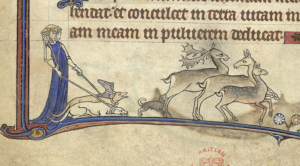Synopsis
Dogs have long been reputed to be man’s best friend. But how long is “long”? The answer is close to 10,000 years (at least). Join Em and Jesse as they look back at the intertwined history of humanity and canine-ity, from Odysseus’s dog Argos to Hachiko, who waited ten years for his owner to come home from work. With some interesting discussions of famous medieval animals, including Alfonso the Wise’s pet weasel and Chanticleer the rooster.

Annotations and Corrections
1/ 1:33 I sound confused about llamas . . . I think I am poorly remembering an argument from Guns, Germs, and Steel. [Some interesting context for Jared Diamond’s Guns, Germs, and Steel. https://www.insidehighered.com/news/2005/08/03/guns-germs-and-steel-reconsidered –Jesse]
2/ 2:08 Talking smack about André [Awwwwwwww.-Jesse]

3/ Our alcohol episode was episode 27.
4/ 7:08 Here is the Wikipedia article about the famous silver fox domestication experiment:
5/ If you’re interested in hunting, check out the famous medieval hunting manuscript Le Livre de chasse written by Gaston Phoebus (Gaston III, Count of Foix) between 1387 and 1389. This text was translated and adapted into English as The Master of Game by Edward of Norwich, 2nd Duke of York between 1406 and 1413.
6/ 10:11 Turnspit dogs! In England, they’re mentioned at least as early as John Caius’s 1570 De canibus Britannicis (On English Dogs)
https://en.wikipedia.org/wiki/Turnspit_dog
7/ There are many references to cats and dogs in the Talmud! Here is the one Em is discussing, and in true Jewish scholarly fashion, there are two possible sayings: 1) don’t go barefoot in a house with a cat because you’ll puncture your foot with the small bones of the snakes it has killed, and 2) don’t go go into a house without a cat in the dark because there might be snakes that will get you.
“Rav Pappa said: With regard to a house in which there is a cat, a person should not enter there barefoot. What is the reason? Because the cat might kill a snake and eat it, and the snake has small bones, and if a small bone gets into one’s foot it cannot be removed, and he will be in danger. Some say that Rav Pappa said: With regard to a house in which there is no cat, a person should not enter there in the dark. What is the reason? Since there is no cat to hunt snakes, perhaps a snake will wrap itself around him without him knowing and he will be in danger.” (Pesachim 112b:10)
Here is a general romp through Talmudic references to cats: https://www.sefaria.org/topics/cats?tab=sources
8/ 12:03 Anchoresses could have cats: see episode 5 (especially note 3).
Domestication of dogs! https://www.smithsonianmag.com/science-nature/how-wolves-really-became-dogs-180970014/
https://www.nature.com/articles/d41586-020-03053-2
9/ 14:58 Pompeii “Beware the Dog” mosaic!
Roman doggo statue (copy of a lost Greek statue): https://en.wikipedia.org/wiki/Molossus_(dog)#/media/File:Molossian_Hound,_British_Museum.jpg
Another Roman doggo: https://www.metmuseum.org/art/collection/search/255121
Greek or Roman girl with puppy: https://www.metmuseum.org/art/collection/search/248754
Greek doggo guarding owner’s tomb (in the National Archaeological Museum in Athens–Jesse can personally attest to this good doggo’s awesomeness). https://commons.wikimedia.org/wiki/File:Funerary_statue_of_a_dog_at_the_National_Archaeological_Museum_of_Athens_on_7_May_2018.jpg
Good Chinese doggos: https://www.metmuseum.org/art/collection/search/42361
https://commons.wikimedia.org/wiki/File:Pottery_dogs,_Han_Dynasty.JPG
Pre-Columbian American doggos:
https://www.metmuseum.org/art/collection/search/318964
https://ncartmuseum.org/art/detail/dog_effigy https://commons.wikimedia.org/wiki/File:Pot-bellied_Dog_Figure,_Mexico,_State_of_Colima,_200_BC_-_500_AD,_ceramic,_Pre-Columbian_collection,_Worcester_Art_Museum_-_IMG_7646.JPG
Neo-Assyrian doggos: https://www.britishmuseum.org/collection/object/W_1856-0903-1509
Some of the oldest depictions of dogs, from Iran: https://www.persee.fr/doc/paleo_0153-9345_2007_num_33_1_5213
Possibly even older depictions of dogs from Saudi Arabia: https://www.smithsonianmag.com/smart-news/8000-year-old-rock-carvings-may-be-earliest-depiction-domesticated-dogs-180967266/
More dogs! https://en.wikipedia.org/wiki/Cultural_depictions_of_dogs
10/ 17:28 Historic dogs vs modern–you’ll notice that lots of the breeds in note 9 are referenced as “extinct” while still looking very recognizable! You can see a bunch of comparison photos from the early 20th century here.
11/ 19:08 Sorry about the eye thing!
HBO’s Real Sports with Bryant Gumbel did a great story on dog breed (“Unnatural Selection”) in season 20 episode 4 (April 2014), but it doesn’t seem to be available for viewing anywhere. So, trigger warning on this article about the problem: https://www.smithsonianmag.com/science-nature/evolution-petface-180967987/
And a more hopeful article https://www.scientificamerican.com/article/although-purebred-dogs-can-be-best-in-show-are-they-worst-in-health/
12/ 19:52 Shout out to Thong Daeng, the most famous basenji of all time, possibly.
13/ Dr. Moudhy Al-Rashid is an Assyriologist who sometimes posts about good Mesopotamian doggos on twitter.
https://twitter.com/moudhy/status/1205801397528211462?s=12
https://twitter.com/Moudhy/status/1205814176293236737
14/ If you’re interested in sirens as funeral monuments, here are some pictures!
https://commons.wikimedia.org/wiki/File:Funerary_statue_of_a_Siren_at_the_National_Archaeological_Museum_of_Athens_on_7_May_2018.jpg
https://commons.wikimedia.org/wiki/File:Funerary_statue_of_a_Siren._4th_cent._B.C.jpg
https://commons.wikimedia.org/wiki/File:Statue_of_Siren.jpg
15/ The train station dog was an Akita named Hachiko. Don’t read that story unless you feel like crying.
16/ Book of Tobit: The dog is not integral to the story but loyally accompanies Tobit’s son Tobias on his travels (notice the brief mentions in the Wikipedia summary). The dog was interpreted as a symbol of loyalty and was a favorite feature of medieval portrayals of The Book of Tobit.
Doggo sleeping on the bed when Tobias gets married (stained glass, 1520): https://collections.vam.ac.uk/item/O64856/tobias-and-sara-on-their-panel-unknown/
Doggo just chilling (1415) http://ica.themorgan.org/manuscript/page/194/112314
And from 1332: https://manuscripts.kb.nl/zoom/BYVANCKB%3Amimi_mmw_10b21%3A088r_min
https://manuscripts.kb.nl/zoom/BYVANCKB%3Amimi_mmw_10b21%3A089v_min
17/ Le Menagier de Paris (1393) https://en.wikipedia.org/wiki/Le_Ménagier_de_Paris
Here is the translation Goodman of Paris. Scroll down to pp. 107–108 for the stories in the podcast.
18/ Dogs protecting lost children: example 1, example 2. There are many more.
19/ St. Guinefort: I swear we discussed him, but I can’t find him in the previous episodes.
https://en.wikipedia.org/wiki/Gelert
20/ The blessing of animals is held on or near St. Francis’s feast day (Oct 4th).
For more on St. Francis of Assisi, see episode 4 notes 14–17 and episode 23 note 7.
21/ The race in Siena is called the PALIO. The “pallagio” is, I assume, an off-brand Vegas hotel. It’s the only race in the world, as far as I know, where a horse that has lost its rider can still win if it finishes first.
22/ Alfonso the Wise’s Cantigas de Santa Maria.
Here is the song in question: http://csm.mml.ox.ac.uk/index.php?p=poemdata_view&rec=354
23/ Riki-tikki-tavi.
24/ The Lady and the Unicorn tapestries at the Musée de Cluny.
Maltese dogs: https://en.wikipedia.org/wiki/Maltese_dog
25/ Chaucer’s Canterbury Tales: the Prioress’s introduction in the General Prologue begins at line 118, and the discussion of her love of animals is lines 142–150.
https://chaucer.fas.harvard.edu/pages/general-prologue-0
Jesse: My claim here might not be true! Obviously far, far more money overall goes to charities that help humans. The discussion here is about a very specific, focused scenario (which still might not be true–the study might have skewed its data to make a point about discrimination). However, there is still a huge debate on whether it’s “immoral” to give to an animal charity “instead of” a human charity. If you want to go down this rabbit hole, feel free to Google!
Em: One thing that I believe is true is that the Royal Society for the Prevention of Cruelty to Animals predates the establishment of similar charities for the prevention of cruelty to children. (RSPCA was established in 1824, the ASPCA was established in 1866, and the New York Society for the Prevention of Cruelty to Children, the first child protective agency in the world, was founded in 1874.
26/ For more on Marie de France (flourished 1160–1215), see episode 19 note 13.
Here is Marie’s fable “The Cock and the Fox.”
Here is Chaucer’s adaptation of Marie’s fable, the Nun’s Priest’s Tale, starring the rooster Chanticleer.
27/ For more on Hildegard of Bingen (1098–1179) see episode 6 beginning around 34:00 and notes 17 and 23. This text is from Book 7 (“Animals”) of the Physica. Dogs are section 20 of this chapter in Priscilla Throop’s translation.
28/ A shout out to Walker-Meikle’s book Medieval Pets.
Also, see Mythbusters episode “Hair of the Dog” (season 8, episode 12) on how hard it is to trick tracking dogs.
This episode is dedicated to Edgar, Maya, and Wrigley! Shout out to Snatch for the title.


Podcast: Play in new window | Download

